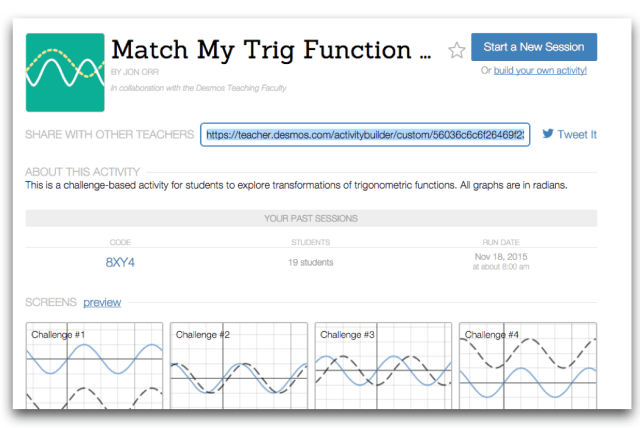I’ve been spiralling my courses for the last few years, but this last semester was the first time I spiralled the Advanced Functions MHF4U course. If you’re new to the spiralling idea check out the blog post from Mary Bourassa and the MHF4U website from Al Overwijk and Janice Bernstein. They’re great resources to get you going.
This post is really to remind my future self on what I did this semester and for anyone else asking spiralling questions.
On Planning
Occasionally I will get an email from a teacher who is interested in trying spiralling and the question they usually ask is, — Where do I start? I think most of us need someone to shine the flash light down the path for us to see where to head. I usually start with a table that shows the strands of the course and where the major skills (overall expectations) fit in. I try to group them by themes. This year I my cycle one was about introducing the functions and focusing on graphing characteristics. Cycle two focused on linking algebraic representations with graphical. See below.
From there I keep an ongoing day-to-day plan.
On Homework:
In the past I’ve given out homework in a very traditional way, “Tonight, complete page ___ Questions #__ to ___. Tomorrow we’ll take them up.” And what did homework take-up look like in a grade 12 course? Well, for me, it was always “What problems did you have trouble with? Number 8b? Ok, does anyone have that one completed? Kearra can you put that solution up on the board?” If no one had that question right, then I would put up a solution. And everyone watched, twiddling their thumbs (or more realistically — texted) while I put that solution up….or we all watched Kearra put the solution up. Not a great use our of time.
I’ve changed that process over the last year or so. For me, giving out homework comes in a homework set. I got the idea from Al Overwijk and Mary Bourassa. The sets not only have practice problems from the ideas from that day, but also practice problems from other areas of the course. Each night of homework they are practicing most strands of the course. It keeps concepts fresh in their minds and keeps practice going all semester.
When students come to class they get a playing card that randomly assigns them a partner. Instead of asking which question we should put up, I choose two or three from the set and the pair has to put them up on the vertical whiteboards/blackboards around the room. They are only allowed one piece of chalk or marker between them. I circulate around the room to give feedback and check for understanding/thinking. I’ll routinely yell out to “switch the marker” which forces students to communicate, error check, and defend their work. A better use of our 10 minute homework take-up time. After, students hand in their homework which allows me to check their understanding and gives me insight on what skills we need to improve on (I choose one or two questions to focus on). Gone are the days where I give out homework and I don’t find out what they really know until test time. Now, I know daily. Is it more work for me? Yes it is. But it’s worth it.
Can’t see the video? Click through to the post

After homework take up.
Whiteboards & Note-taking:
Most of our problem solving and practice work in class this year was done on non-permanent surfaces. For some students, parents, and teachers this is a concern since they are wiped away and there is not a record of that work. Here is an email response I sent a fellow teacher this year to address the concern:
“Do your students need the note? Are they asking to take notes? If so, have a conversation with them about what they need and teach them to take pictures of what they need or make notes for themselves. Or have them summarize what they’ve learned after doing the problems as an exit slip.
I sometimes do “important” solutions on chart paper and then they stay up in the room so we can refer back to them.”
Changes:
As always I’ll be making changes for the next time I teach the course. I want to include solving equations earlier in the course. This year I didn’t bring it in until cycle 3 and I feel like we could have benefited from more exposure. Also, radians need to be introduced in cycle 1 so that it can fuel all of trig for the rest of the year. I feel like it was crammed into the last cycle.
Day-to-Day Outline and resources for MHF4U
Get your OWN copy of the Google Sheet to modify. – You’ll need a Google account





















